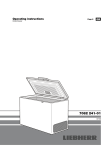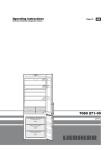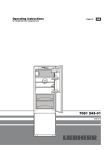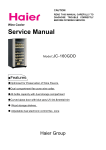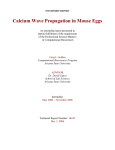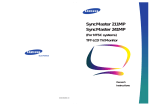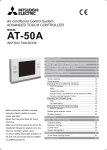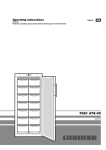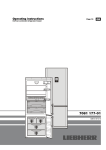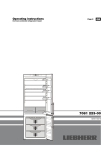Download Liebherr CNPES 5156
Transcript
Operating instructions
No-frost combined refrigerator-freezer
Page 12
GB
7083 267-00
CN 56
Disposal notes
The appliance contains reusable materials and should
be disposed of properly - not simply with unsorted
household refuse. Appliances which are no longer
needed must be disposed of in a professional and
appropriate way, in accordance with the current local
regulations and laws.
When disposing of the appliance, ensure that the refrigerant circuit
is not damaged to prevent uncontrolled escape of the refrigerant
it contains (data on type plate) and oil.
• Disable the appliance.
• Pull out the mains plug.
• Cut through the connection cable.
WARNING
Danger of suffocation due to packing material and plastic film!
Do not allow children to play with packaging material. Take the
packaging material to an official collection point.
Range of appliance use
The appliance is suitable solely for cooling food in
a domestic environment or similar. This includes,
for example, use
- in staff kitchenettes, bed and breakfast establishments,
-by guests in cottages, hotels, motels and other
forms of accommodation,
-in catering and similar services in the wholesale
trade.
Use the appliance solely as is customary within a domestic environment. All other types of use are inadmissible. The appliance
is not suitable for storing and cooling medicines, blood plasma,
laboratory preparations or similar substances and products covered by the 2007/47/EC Medical Devices Directive. Any misuse
of the appliance may result in damage to or spoilage of stored
goods. Furthermore, the appliance is not suitable for operation in
potentially explosive atmospheres.
Description of the appliance
Butter and cheese compartment - Vario Box
Interior light
(LED light strip)
Bottle grid
Operating and
control elements
Refrigerator
compartment
Adjustable storage shelves
Adjustable door rack
Type plate
Vegetable bins
Freezer
compartment
Drawers
Freezing chart
Adjustable-height feet
Extend the adjustable foot at the turn
hinge until it rests on the floor and then
make a further 90° turn.
12
Safety instructions and warnings
•To prevent injury or damage to the unit, the appliance should be unpacked and set up by two
people.
•In the event that the appliance is damaged on
delivery, contact the supplier immediately before
connecting to the mains.
•To guarantee safe operation, ensure that the appliance is set up and connected as described in
these operating instructions.
•Disconnect the appliance from the mains if any
fault occurs. Pull out the plug, switch off or remove
the fuse.
•When disconnecting the appliance, pull on the
plug, not on the cable.
•Any repairs and work on the appliance should
only be carried out by the customer service
department, as unauthorised work could prove
highly dangerous for the user. The same applies
to changing the mains power cable.
•Do not allow naked flames or ignition sources to
enter the appliance.When transporting and cleaning the appliance ensure that the refrigerant circuit
is not damaged. In the event of damage, make
sure that there are no ignition sources nearby and
keep the room well ventilated.
•Do not stand on the plinth, drawers or doors or
use them to support anything else.
•This appliance can be used by children of 8 years
old and over, and also by persons with restricted
physical, sensory or mental capacity or lack of
experience and knowledge, if they are supervised
or have been instructed on safe use of the appliance and understand the resulting risks. Children
must not be allowed to play with the appliance.
Cleaning and user maintenance must not be carried out by children without supervision.
GB
•Do not store explosives or sprays using combustible propellants such as butane, propane, pentane
etc. in the appliance. Electrical components might
cause leaking gas to ignite.You may identify such
sprays by the printed contents or a flame symbol.
•Do not use electrical appliances inside the appliance.
•The appliance is designed for use in enclosed
areas. Do not operate the appliance outdoors or
in areas where it is exposed to splash water or
damp conditions.
•The LED light strips illuminate the interior of the
appliance.They are not suitable for lighting a room.
Climate rating
The climate rating indicates the room temperature at which the appliance may be
operated in order to achieve full refrigeration
performance.
The climate rating is indicated on the type
plate.
The position of the type plate is shown in
the section entitled Description of the appliance.
Climate rating
SN
N
ST
T
SN-ST
SN-T
Room temperature
+10°C to +32°C
+16°C to +32°C
+16°C to +38°C
+16°C to +43°C
+10°C to +38°C
+10°C to +43°C
Do not operate the appliance outside the specified room temperature range.
•Avoid prolonged skin contact with cold surfaces or
chilled/frozen food. This could cause pain, numbness and frostbite. In the case of prolonged skin
contact, protective measures should be taken,
e.g. gloves should be worn.
•Do not eat ice cream, particulary ice lollies or ice
cubes, immediately after taking them from the
freezer compartment as there is a risk of "burning" because of the very cold temperatures.
•Do not consume food which has been stored for
too long, as it could cause food poisoning.
13
Setting up
• Do not place the appliance in areas of direct sunlight or next to a
cooker, radiator or similar object.
• The floor on which the appliance stands should be horizontal and
level. To compensate for any unevenness, adjust the height of the
feet with the open-ended spanner supplied.
• Do
not cover ventilation openings
or grille.
• Do not place heat-emitting appliances, e.g.
microwave oven, toaster, etc., on top of the
appliance.
• Standard EN 378 specifies that the room in
which you install your appliance must have a
volume of 1 m3 per 8 g of R 600a refrigerant
used in the appliance, so as to avoid the formation of inflammable gas/air mixtures in the room
where the appliance is located in the event of
a leak in the refrigerant circuit. The quantity of
refrigerant used in your appliance is indicated
on the type plate on the inside of the appliance.
• To ensure that the stated energy
consumption is achieved, the wall
spacers supplied with the appliance
must be used. This increases the
depth of the appliance by approx.
35 mm.
Electrical connection
Only operate the appliance with alternating current (AC).
The permissible voltage and frequency are indicated on the type
plate. The position of the type plate is shown in the section entitled
Description of the appliance.
The socket must be properly earthed and protected by a fuse.
The tripping current of the fuse must be between 10 A and 16 A.
The socket must not be situated behind the appliance and must be easily accessible.
Do not connect the appliance using an extension cable or extension socket.
Do not use stand-alone inverters (conversion
of direct current to alternating current/threephase current) or energy-saving plugs. Risk
of damage to the electronic control system!
Operating and control elements
The appliance is fully operational even
if the spacers are not used. It does,
however, have a slightly higher energy
consumption.
Fit the spacers to the back of
the appliance on the left and
right at the top.
Dimensions (mm)
(1) On/Off button, refrigerator compartment
(2) Alarm symbol
(3) SuperCool button
(4) SuperFrost button
(5) SuperFrost symbol
(6) On/Off button, freezer compartment
(7) Ventilation button
(8) Alarm button
(9) Down setting button, freezer compartment
(10) Freezer compartment temperature display
(11) Up setting button, freezer compartment
(12) Refrigerator compartment temperature display
(13) Down setting button, refrigerator compartment
(14) Ventilation symbol
(15) Up setting button, refrigerator compartment
(16) Child-proofing symbol
(17) Power failure symbol
(18) Menu symbol > Setup mode is activated (activating the
child lock and adjusting the display brightness)
(19) Net@Home symbol
(20) SuperCool symbol
14
Switching the appliance on and off
Brightness of the temperature display
GB
Clean the interior of the appliance before switching it on for the
first time (see "Cleaning").
You can adjust the brightness of the temperature display to the
light conditions of the room in which the appliance is installed.
To switch on
Press the On/Off button 1 or 6 so that the temperature displays
light up.
Adjusting the brightness
To switch the refrigerator compartment off
Press the On/Off button 1 for approx. two seconds.
• Press the SuperFrost button 4 for
about 5 seconds.
Note: If the freezer compartment
(On/Off button 6) is switched off, the
entire appliance will be switched off.
Setting the temperature
The brightness is adjustable between
5 (maximum brightness).
0 (no illumination) and
• The display indicates .
• Using the Up button
button 9select .
bm or Down
• Briefly press the SuperFrost button
4.
• To make the display brighter: press
Up button bm.
The temperature of the refrigerator
and freezer compartment can be
set separately.
• To make the display darker: press
Down button 9.
Setting the refrigerator temperature
Warmer temperature setting > press button bq
Colder temperature setting > press button bo
• The brightness is adjusted to the new value.
Setting the freezer temperature
Warmer temperature setting > press button bm
Colder temperature setting > press button 9
- While you are setting the temperature, the temperature display
will flash.
-When you press the setting buttons for the first time, the set
temperature will be displayed.
- You can change the settings in increments of 1°C by briefly pressing the buttons again.
- About 5 seconds after the button was last pressed the average
interior temperature will be displayed.
Adjustable temperature ranges
Refrigerator compartment: 11°C to 2°C.
Freezer compartment: -16°C to -26°C.
Saving energy
- Always ensure good ventilation. Do not cover ventilation openings
or grille.
- Always keep fan louvres clear.
- Do not place appliance in areas of direct sunlight or next to a
stove, heater or similar object.
- The energy consumption depends on the installation conditions,
e.g. the ambient temperature.
- Keep the time the appliance is open to a minimum.
- Store food logically.
- Ensure that all food is well packed and covered for storage. This
will prevent frost from forming.
- First cool warm food to room temperature before storing it.
- Defrost frozen food in the refrigerator.
- If there is a thick layer of frost in the appliance: defrost the appliance.
- Empty and switch off refrigerating unit for longer vacation periods.
- Use the vacation function for longer vacation periods.
• Press the SuperFrost button 4.
• Press the freezer compartment On/Off button
minutes.
6 or wait for 5
Child proofing
The child-proofing function enables you to make sure that the
appliance is not inadvertently switched off by playing children.
Setting the child-proofing function
• Press the SuperFrost button 4 for about 5 seconds.
• The display indicates .
• Briefly press the SuperFrost button
4 to confirm.
When 1 is indicated in the
display:
• To activate the child lock, briefly
press the SuperFrost button 4.
• The child lock symbol
up.
flashes in the display.
lights
When 0 is indicated in the
display:
• To deactivate the child lock, briefly
press the SuperFrost button 4.
• The child lock symbol
flashes in the display.
goes out.
• Press the On/Off button 6 or wait for 5 minutes.
Accumulated dust increases the energy consumption:
- Once a year, dust the refrigerating unit together with the metal
grille of the heat exchanger at the back of the appliance.
15
Audible warning signal
Audible door alarm
If an appliance door is left open for more than
60 seconds, the audible warning signal will
sound. Press the audible warning on/off button
8 to cancel the alarm. The alarm switches back
to standby when the door is shut.
Audible/visual temperature alarm
If the temperature in the freezer compartment
rises too high, the audible warning signal will
sound and the alarm symbol 2 and the temperature display will flash.
Press the audible warning on/off button 8
to cancel the alarm. The symbol 2 will stop
flashing. The symbol 2 will disappear as soon
as the temperature in the freezer compartment
is low enough.
Equipment
You can re-arrange the storage shelves
as required.
Lift the glass shelf, align the recess over the
support and replace the shelf in a higher or
lower position.
Place the shelf rails provided, fig. 1, on the supports on the left and
right at the desired height.
Insert the glass shelves 1 and 2 as shown in fig. 2.
If you need to make space for tall containers, simply slide the
front half of the sectioned glass shelf carefully underneath the
back half, fig. 2.
This can be caused by:
• the freezer door being left open for a long time,
allowing warm ambient air to enter;
• a long power failure;
• a fault in the appliance.
In each case, make sure food has not thawed or perished. If the
alarm symbol does not go out, contact the customer service department (see section on Malfunctions).
Net@Home
The appliance can be provided
with the retrofit modules for the
HomeDialog system or the serial
interface (RS 232), depending on
model and equipment.
The modules are available from your
specialist dealer.
fig. 1
Repositioning the door racks
- Lift door rack vertically (1), lift out to the
front and re-insert at a different height, following these steps in the reverse order (2).
- By shifting the bottle holder F you can
protect the bottles from falling over when
opening or closing the door.
You will find more information on the internet at www.liebherr.com.
Power failure display
If
appears in the display, the
freezer temperature has risen too
high due to a power failure.
• Press the Alarm button 8.
>The highest temperature during the
power failure will be displayed.
Check the quality of the food
depending on the temperature
displayed.
Do not eat perished food!
Do not refreeze thawed food!
Press the Alarm button 8 again to
cancel the display.
16
The boxes can be removed and placed on
the table as a single unit.
• Re-positioning the boxes: Lift them for
removal and re-position them as required.
The box support bar can be removed by
lifting upwards and inserted in another
position (e.g. swapped with a door rack).
Important! Box lids must be shut when you
close the door - risk of damage.
To detach the lid
Open 90° and raise to disengage.
fig. 2
Interior light (Refrigerator compartment)
The interior light will always
switch on when the appliance
door is opened.
The light intensity of the
LED light corresponds to
laser class 1/1M.
Important
The light cover may only be removed by customer service
staff. If the cover is removed, do not look directly at the
light through optical lenses from close distance. This can
damage your eyes.
Cooling
GB
Storage example
1butter, cheese
2eggs, cans, tubes
3bottles
4frozen food, ice cubes
5meat, sausage products, dairy
products
6baked goods, pre-cooked meals,
drinks
7fruit, vegetables, salad
Note
• Food which gives off or absorbs odours
and flavours as well as liquids should
always be stored covered or in closed
containers. High-percentage alcohols
should be tightly sealed and stored
upright.
• Reuseable plastic, metal, aluminium and glass containers can be
used for packaging.
SuperCool
By activating the SuperCool function, the temperature in the refrigerator compartment will drop to its lowest value. It is recommended
if large quantities of food are to be cooled rapidly.
To switch on: Press the SuperCool button 3 briefly > LED cl
lights up.
Note: The SuperCool function switches off automatically after
about 6 hours.
Cooling with fan
With the fan function switched on, a
uniform temperature distribution will
be attained in the refrigerator compartment.
This is recommended:
- in high room temperatures (approx.
33°C or higher),
- if the air humidity is high (e.g. during
the summer).
To switch on
Press the fan button 7 - the symbol
bp lights up.
17
Freezing
Defrosting
The maximum amount of food
(in kg) which can be frozen in
24 hours is shown on the type
plate ("Freezing capacity").
Refrigerator compartment
The position of the type plate
is shown in the section entitled
Description of the appliance.
Freezer compartment
SuperFrost
By activating the SuperFrost function the temperature in the freezer
compartment will drop to the lowest attainable value. Thus food
can be rapidly frozen to the core and the quality is preserved.
• Press the SuperFrost button 4 the SuperFrost symbol 5 lights
up.
• For small amounts of frozen food,
switch on SuperFrost 6 hours
beforehand, and for the maximum
quantity 24 hours beforehand.
• Place the fresh food in the freezer.
• Depending on the quantity of food placed in the freezer, the appliance switches back to normal operating mode after 30 to 65
hours.
You should not switch on the SuperFrost function
- when placing frozen food in the freezer,
- when freezing up to approx. 2 kg fresh food daily.
Notes on freezing
• Pack food which you are freezing yourself in quantities appropriate
to your household. To ensure that the food freezes right through,
the following quantities should not be exceeded per package:
fruit, vegetables: up to 1 kg, meat: up to 2.5 kg.
• Do not allow fresh food which is to be frozen to come into contact
with food already frozen. Always keep packs dry in order to avoid
them sticking together.
• Always write the date and contents on the pack and do not exeed
the stated storage time for the food.
• Do not freeze bottles and cans which contain carbonated drinks
as they might burst.
• Only take out as much food as is immediately required for thawing.
Use food which has been thawed in prepared meals as quickly
as possible.
Frozen food can be thawed in the following ways: in a fan
oven, in a microwave oven, at room temperature, in the refrigerator.
Making ice cubes
• Fill the ice-cube tray with water.
• Place the ice-cube tray in the appliance
and leave it to freeze.
• The ice cubes can be removed from the
tray by twisting or by holding upside down for a
short time under running water.
18
The refrigerator compartment defrosts automatically. The water that
forms on the rear wall drains into a reservoir at the back of the appliance and evaporates automatically through the compressor heat.
The No-frost system automatically defrosts the appliance.
Any moisture arising collects on the evaporator and freezes, and
is periodically defrosted and evaporated.
Cleaning
Before cleaning always switch off the appliance. Pull out the
mains plug or remove/unscrew the fuse.
• First clean the side panels with a conventional stainless steel
cleaner. Subsequently, apply the enclosed stainless steel care
product evenly onto the surfaces in the same direction in with
they have been ground or polished.
• Only clean the door surfaces with a clean and soft cloth. If necessary, moisten the cloth (water + detergent). Alternatively, use a
micro-fibre cloth.
- Do not use abrasive sponges or scourers, do not use concentrated
cleaning agents and never use cleaning agents containing sand,
chloride or acid or chemical solvents, as these would damage the
surfaces and could cause corrosion.
• Clean the inside and equipment parts with lukewarm water and
a little detergent.
Do not use steam cleaners because of the risk
of injury and damage.
• Ensure that no cleaning water penetrates into the electrical components or ventilation grille.
• Dry all parts well with a cloth.
• Do not damage or remove the type plate on the inside of the appliance. It is very important for servicing purposes.
Malfunctions
GB
Installing appliance in a row of kitchen units
You may be able to rectify the following faults by checking
the possible causes yourself:
To adapt the height of the appliance to the surrounding furniture
a top unit 1 can be added.
• Appliance does not function:
–Is the appliance switched on?
–Is the plug correctly fitted in the mains socket?
–Is the socket fuse intact?
A gap of at least 50 mm
depth must be provided
behind and along the entire
width of this unit so as to
ensure sufficient ventilation. The area of ventilation underneath the ceiling
should be at least 300 cm2.
• Loud running noise:
–Is the appliance set up firmly on the floor?
–Does the appliance cause nearby items of furniture or objects to
vibrate? Please note that noises caused by the refrigerant circuit
cannot be avoided.
• The temperature is not low enough:
– Is the temperature setting correct (see "Setting the temperature")?
–Have excessive amounts of fresh food been placed in the appliance?
– Does the separately installed thermometer show the correct reading?
– Is the ventilation system working properly?
– Is the appliance set up too close to a heat source?
If none of the above causes
apply and you cannot rectify
the fault yourself, contact the
nearest customer service department stating the type designation 1, service number 2
and appliance number 3 as
indicated on the type plate.
When setting up the appliance next to a wall 4, a
distance of approx. 50 mm
must be provided on the
hinge side between the
appliance and the wall (for
the handle when the door
is open).
1 top unit
2 refrigerator-freezer
3 kitchen unit side panel
4 wall
The position of the type plate is shown in the section entitled
Description of the appliance.
Shutting your appliance down
If your appliance is to be shut down for any length of time, switch
it off and disconnect the plug or switch off or unscrew the fuse.
Clean the appliance and leave the door open in order to prevent
unpleasant smells.
The appliance complies with the relevant safety regulations and
EC Directives 2004/108/EC and 2006/95/EC.
19
Changing over door hinges
Door hinges should only be changed by a trained expert.
Changing the door hinges must be done by two people.
Caution! Before changing over door hinges, disconnect
the appliance from the mains.
1.Open top door.
2.To remove the cover on the
handle side: disengage the
cover on the right using a
flat-blade screwdriver and
push it outwards.
3.To remove the cover on the
hinge side: disengage the
cover on the left using a flatblade screwdriver and push it outwards.
12.Lever out pressure plates at the front
and slide away.
13.Transfer door handles and plugs to
the other side.
14.Transfer spring clip to the opposite
side.
4.Remove the front panel using a flat-blade screwdriver.
5.Remove contact and disconnect plug connector. Detach
grey cable from the guide.
15.Unscrew hinge bracket.
16.Transfer cover plate to the
opposite side.
17.Turn hinge bracket through
180° and screw into place.
6.Remove cover.
7.Undo the screws.
8.Lift and remove the door complete
with hinge and cable.
18.Remove hinge bushing, turn
through 180° and re-fit.
20
9.Transfer cover plate to the opposite side.
19. Tilt appliance slightly backwards
and unscrew the adjustable foot.
20. Remove the hinge pin.
21. Unscrew hinge bracket.
21
19
10.Pull out middle hinge pin.
11.Remove bottom door.
22
22. Transfer the hinge component on
the hinge bracket to the opposite
side.
20
GB
32
23
23. Transfer cover to the opposite side.
32.Using a screwdriver, push out the
plug from underneath and transfer it
to the opposite side.
24. Transfer cover plate to the opposite side.
33.Feed in the cable of the hinge
at the opposite side and insert hinge.
24
25. Screw hinge bracket into place.
33
34.Plug in the plug. Place the
cable in the guide.
25
35.Engage the cover on the door.
34
35
26. Tilt appliance slightly backwards,
insert pin and attach using the
adjustable foot.
26
36
36.Suspend top door on hinge pin and
close.
27. Suspend bottom door on the
bottom hinge pin and close.
38
27
37
37. Insert hinge bracket and screw into
place.
28
28.Insert middle hinge pin.
38. Click cover into place.
39.Open the top door and
click all covers into place
again.
31
29.Using a screwdriver, remove
the cover on the door.
30.Disconnect the plug.
31.Using a screwdriver, push out
the hinge from underneath
and remove it from the door
complete with cable.
39
30
29
40. Place the appliance in its final position
at the place of installation.
Extend the adjustable foot at the bottom
hinge bracket until it rests on the floor
and then make a further 90° turn.
21











